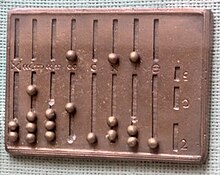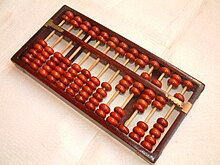Abacus (arithmetic aid)
An abacus ( plural abacuses or abaki ) is a simple mechanical calculation aid . It contains balls, mostly wooden or glass beads; the comparable abacus and coins (come Rechenpfennige ) or computing stones ( calculi ) are used. Depending on the design, the designation counting frame or computing frame is also used.

Word origin
Abacus is borrowed in Middle High German from the Latin word abacus and the Greek word ἄβαξ abax (genitive ἄβακος ábakos ), which means "board" or "board". The Greek ἄβαξ possibly comes from a Semitic word such as the Hebrew ibeq , which means “to wipe dust” (noun abaq , “dust”).
description
The abacus consists of a frame with balls or stones that are threaded onto rods or guided in grooves, grooves or slots. The version with balls is also known as the Russian abacus ( Stschoty , probably from Russian Stschot, Russian счёт , invoice) because it was used there in this version. The spheres or calculating stones represent a certain number due to their position, which means that a system of value is usually used as a basis. The Russian abacus does not have the same classification as in other countries, in which a part of the balls is separated, which have a higher value (usually five times). The Russian version usually uses a separate fraction calculation board for this.
An abacus enables the basic arithmetic operations of addition , subtraction , multiplication and division as well as the extraction of square and cube roots . Most arithmetic operations can not be easily performed with the Roman numerals . That is why there was the slightly modified Roman abacus.
history
The abacus is one of the oldest known calculation aids and is believed to be of Sumerian origin. The first abacus appeared between around 2700 and 2300 BC. And was a wooden or clay tablet that was divided into columns, each column representing a place in the Sumerian sexagesimal system . On top of this, stones of the same size made of clay or short reeds were placed. The Sumerians recognized that calculating on lines or columns was more efficient than with calculating stones of various kinds , where the size or shape indicated the position in the number system.
The Babylonians took over the abacus and translated them into the decimal system . Around 2000 BC There was a profound change: the Babylonians began to write the numbers directly on clay tablets, intermediate results could be deleted and rewritten after each operation. Over time, the soft clay tablets were replaced by hard surfaces such as stone or metal, and the numbers were engraved in the sand. The abacus spread from Babylonia to India , Persia and the Mediterranean region through trade .
The Salaminische Tafel around 300 BC is the oldest surviving abacus-based abacus . The Roman abacus had rows of slots with which the calculating stones could be moved in fixed paths.
In the sixth century, a "pearl calculation", Zhusuan ( 珠算 , zhūsuàn - "literally calculating with pearls") is mentioned for the first time in China . Around AD 1600, the Japanese took over the abacus from the Chinese and simplified it.
The abacus was widespread in the Middle Ages and was used until around the 17th century. After the introduction of the Indian numerals , it became less important because of the possibility of written calculations . The abacus has been supplanted by mechanical calculating machines since the middle of the 17th century, but is still in use as a calculation aid for the blind. In Eastern Europe and Asia it is occasionally still used as an inexpensive calculating machine in small shops. Aztec abaki (from about AD 900–1000) have also been found during excavations .

The most common forms are the European abacus, the Chinese suanpan ( 算盤 / 算盘 , suànpán - "literal abacus"), the Japanese soroban and the Russian stschoty . Zhusuan ( 珠算 , zhūsuàn - "calculating with the abacus"), the traditional calculation method using the suanpan , was added to the UNESCO Representative List of the Intangible Cultural Heritage of Humanity in 2013 .
functionality
When using the abacus, calculations are made by adding positive or negative numbers to set the new total as the result. So, learning the abacus math skill is essentially about learning how to set each number to add or subtract for each starting number (0 to 9). If, as a result of constant practice, the fingers themselves “know” what to do without thinking, the numbers can be entered much faster than on an electronic calculator. However, the time savings are only available with addition and subtraction, as they are usually required in retail .
Multiplication and division as well as the extraction of the roots are traced back to multiple addition or subtraction , as is the case with the use of mechanical calculating machines according to the methods of written calculation.
See also
literature
- Takashi Kojima: Advanced Abacus Japanese Theory and Practice , Charles E. Tuttle Company, Rutland, Vermont & Tokyo, Japan, 6.ed., ISBN 0-8048-0003-0 .
- Werner Bergmann: Innovations in the Quadrivium of the 10th and 11th Centuries. Studies on the introduction of the astrolabe and abacus in the Latin Middle Ages . Sudhoff's archive. Journal of the History of Science. Supplements, booklet 26. Habilitation, Bochum 1985. Steiner, Stuttgart 1985. ISBN 3-515-04148-6 .
Web links
- Abacus . In: Paulys Realencyclopadie der classischen Antiquity Science (RE). Volume I, 1, Stuttgart 1893, Sp. 5-10.
- Technical work abacus - history and functionality of the Chinese abacus
- Instructions on how to calculate with the European abacus
Individual evidence
- ^ Friedrich Kluge: Etymological dictionary of the German language. 22nd edition, de Gruyter, 1989, p. 2.
- ↑ a b c Guido Walz (Ed.): Lexicon of Mathematics. Volume 1: A to Eif. 2nd edition, Springer, 2017, p. 1.
- ^ Yoshihide Igarashi, Tom Altman et al .: Computing. A Historical and Technical Perspective. CRC Press, 2014, pp. 59-60.
- ^ Yoshihide Igarashi, Tom Altman et al .: Computing. A Historical and Technical Perspective. CRC Press, 2014, p. 60.
- ^ Yoshihide Igarashi, Tom Altman et al .: Computing. A Historical and Technical Perspective. CRC Press, 2014, p. 61.
- ↑ Helmut Herold, Bruno Lurz, Jürgen Wohlrab: Fundamentals of Computer Science . Pearson Studium, Munich 2007, ISBN 978-3-8273-7305-2 , p. 25
- ↑ 30 new entries in UNESCO lists of intangible cultural heritage. UNESCO dated December 5, 2013.



